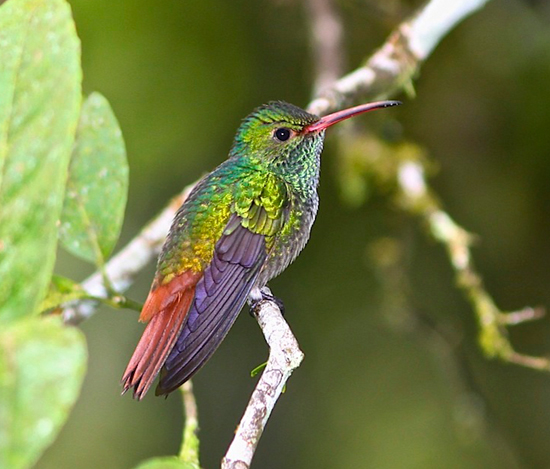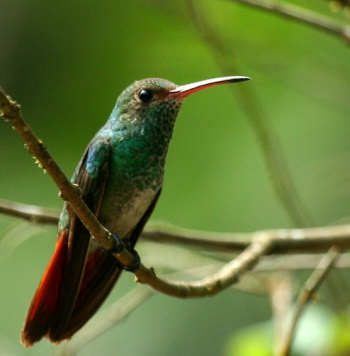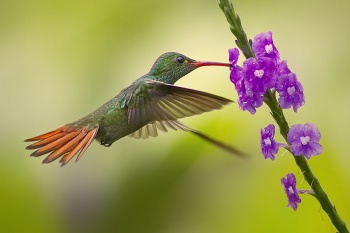- Amazilia tzacatl
Identification
8–11 cm (3-4¼ in)
- Green throat (edged whitish in the female)
- Crown, back and flanks are green with golden tints
- Pale grey belly
- Rufous vent and rump
- Rufous, slightly forked tail, with a dusky tip
- Black-tipped red bill is almost straight
Similar species
Buff-bellied Hummingbird, Cinnamon Hummingbird, and Berylline Hummingbird
Distribution
Central America: Mexico, Guatemala, Belize, Honduras, Nicaragua, Costa Rica, Panama
South America: Colombia, Venezuela, Ecuador, Peru
Taxonomy
Subspecies
Five subspecies are recognized[1]:
- A. t. tzacatl:
- A. t. fuscicaudata:
- A. t. brehmi:
- Colombia (Nariño)
- A. t. jucunda:
- A. t. handleyi (Escudo):
- Isla Escudo de Veraguas (off Caribbean coast of north-western Panama)
The last of these is sometimes considered a full species Escudo Hummingbird (Amazilia handleyi); this is larger and darker than mainland birds.
Habitat
Tropical dry and rain forest, degraded subtropical montane forest up to 1850 m, open country, river banks, woodland, scrub, forest edge, coffee plantations and gardens .
Behaviour
Sometimes engages in extreme fights.
Breeding
The female builds a compact cup nest from plant-fibre and dead leaves 1-6 m high on a thin horizontal twig. The 2 white eggs are incubated solely by the female for 15-19 days, and fledging after 20-26.
Diet
The diet includes nectar, taken from a variety of flowers, and it also takes small insects.
References
- Clements, J. F., T. S. Schulenberg, M. J. Iliff, D. Roberson, T. A. Fredericks, B. L. Sullivan, and C. L. Wood. 2017. The eBird/Clements checklist of birds of the world: v2017, with updates to August 2017. Downloaded from http://www.birds.cornell.edu/clementschecklist/download/
- Avibase
- Wikipedia
- BF Member observations
- Birdforum photo with description of fighting behavior
Recommended Citation
- BirdForum Opus contributors. (2025) Rufous-tailed Hummingbird. In: BirdForum, the forum for wild birds and birding. Retrieved 27 April 2025 from https://www.birdforum.net/opus/Rufous-tailed_Hummingbird
External Links
GSearch checked for 2020 platform.1






